Related Research Articles

In geology and mineralogy, a mineral or mineral species is, broadly speaking, a solid substance with a fairly well-defined chemical composition and a specific crystal structure that occurs naturally in pure form.

Hornblende is a complex inosilicate series of minerals. It is not a recognized mineral in its own right, but the name is used as a general or field term, to refer to a dark amphibole. Hornblende minerals are common in igneous and metamorphic rocks.

Amphibole is a group of inosilicate minerals, forming prism or needlelike crystals, composed of double chain SiO
4 tetrahedra, linked at the vertices and generally containing ions of iron and/or magnesium in their structures. Its IMA symbol is Amp. Amphiboles can be green, black, colorless, white, yellow, blue, or brown. The International Mineralogical Association currently classifies amphiboles as a mineral supergroup, within which are two groups and several subgroups.
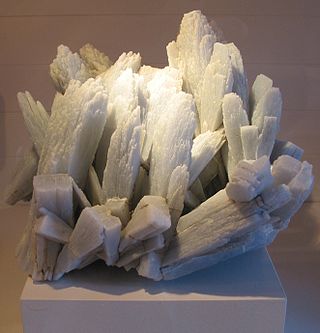
Anhydrite, or anhydrous calcium sulfate, is a mineral with the chemical formula CaSO4. It is in the orthorhombic crystal system, with three directions of perfect cleavage parallel to the three planes of symmetry. It is not isomorphous with the orthorhombic barium (baryte) and strontium (celestine) sulfates, as might be expected from the chemical formulas. Distinctly developed crystals are somewhat rare, the mineral usually presenting the form of cleavage masses. The Mohs hardness is 3.5, and the specific gravity is 2.9. The color is white, sometimes greyish, bluish, or purple. On the best developed of the three cleavages, the lustre is pearly; on other surfaces it is glassy. When exposed to water, anhydrite readily transforms to the more commonly occurring gypsum, (CaSO4·2H2O) by the absorption of water. This transformation is reversible, with gypsum or calcium sulfate hemihydrate forming anhydrite by heating to around 200 °C (400 °F) under normal atmospheric conditions. Anhydrite is commonly associated with calcite, halite, and sulfides such as galena, chalcopyrite, molybdenite, and pyrite in vein deposits.

Leadhillite is a lead sulfate carbonate hydroxide mineral, often associated with anglesite. It has the formula Pb4SO4(CO3)2(OH)2. Leadhillite crystallises in the monoclinic system, but develops pseudo-hexagonal forms due to crystal twinning. It forms transparent to translucent variably coloured crystals with an adamantine lustre. It is quite soft with a Mohs hardness of 2.5 and a relatively high specific gravity of 6.26 to 6.55.
Geigerite is a mineral, a complex hydrous manganese arsenate with formula: Mn5(AsO3OH)2(AsO4)2·10H2O. It forms triclinic pinacoidal, vitreous, colorless to red to brown crystals. It has a Mohs hardness of 3 and a specific gravity of 3.05.
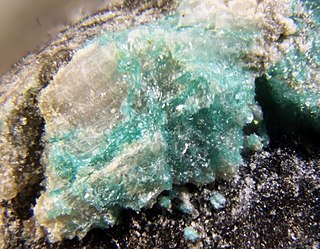
Campigliaite is a copper and manganese sulfate mineral with a chemical formula of Cu4Mn(SO4)2(OH)6·4H2O. It has a chemical formula and also a crystal structure similar to niedermayrite, with Cd(II) cation replacing by Mn(II). The formation of campigliaite is related to the oxidation of sulfide minerals to form sulfate solutions with ilvaite associated with the presence of manganese. Campigliaite is a rare secondary mineral formed when metallic sulfide skarn deposits are oxidized. While there are several related associations, there is no abundant source for this mineral due to its rare process of formation. Based on its crystallographic data and chemical formula, campigliaite is placed in the devillite group and considered the manganese analogue of devillite. Campigliaite belongs to the copper oxysalt minerals as well followed by the subgroup M=M-T sheets. The infinite sheet structures that campigliaite has are characterized by strongly bonded polyhedral sheets, which are linked in the third dimension by weaker hydrogen bonds.
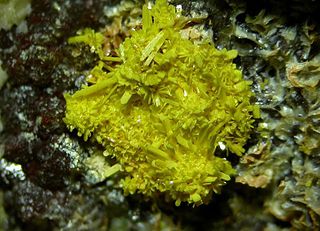
Bergenite is a rare uranyl phosphate of the more specific phosphuranylite group. The phosphuranylite-type sheet in bergenite is a new isomer of the group, with the uranyl phosphate tetrahedra varying in an up-up-down, same-same-opposite (uuduudSSOSSO) orientation. All bergenite samples have been found in old mine dump sites. Uranyl minerals are a large constituent of uranium deposits.
Clearcreekite is a carbonate mineral, polymorphous with peterbaylissite. The chemical formula of clearcreekite is Hg1+3CO3(OH)∙2H2O. It has a pale greenish yellow color and streak with tabular subhedral crystals and good cleavage on {001}. It is transparent with vitreous luster and uneven fracture. Its density (calculated from the idealized formula) is 6.96 g/cm3. The mineral is monoclinic with the space group P2/c. Clearcreekite is an extremely rare mineral from the Clear Creek mercury mine, New Idria district, San Benito County, California. It was probably formed after the alteration of other mercury minerals such as cinnabar. The mineral is named after the locality where it was found.

Cornubite is a rare secondary copper arsenate mineral with formula: Cu5(AsO4)2(OH)4. It was first described for its discovery in 1958 in Wheal Carpenter, Gwinear, Cornwall, England, UK. The name is from Cornubia, the medieval Latin name for Cornwall. It is a dimorph of Cornwallite, and the arsenic analogue of pseudomalachite.
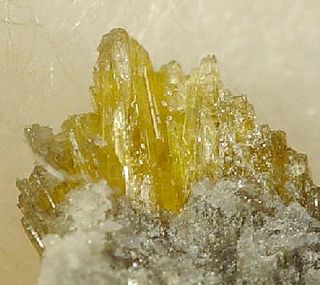
Warikahnite is a rare zinc arsenate mineral of the triclinic crystal system with Hermann- Mauguin notation 1, belonging to the space group P1. It occurs in the Tsumeb mine in Namibia on corroded tennantite in the second oxidation zone under hydrothermal conditions in a dolomite-hosted polymetallic ore deposit. It is associated with adamite, stranskiite, koritnigite, claudetite, tsumcorite, and ludlockite. The origin of discovery was in a dolomite ore formation within an oxidized hydrothermal zone, in the E9 pillar, 31st level of the Tsumeb Mine in Namibia, Southwest Africa. It has also been found at Lavrion, Greece and Plaka, Greece as microscopic white needles.

Hidalgoite, PbAl3(AsO4)(SO4)(OH)4, is a rare member of the beudantite group and is usually classified as part of the alunite family. It was named after the place where it was first discovered, the Zimapán mining district, Hidalgo, Mexico. At Hidalgo where it was initially discovered, it was found as dense white masses in alternating dikes of quartz latite and quartz monzonite alongside other secondary minerals such as sphalerite, arsenopyrite, cerussite and trace amounts of angelsite and alamosite, it was then rediscovered at other locations such as Australia where it occurs on oxidized shear zones above greywacke shales especially on the anticline prospects of the area, and on fine grained quartz-spessartine rocks in Broken Hill, Australia. Hidalgoite specimens are usually associated with copper minerals, clay minerals, iron oxides and polymetallic sulfides in occurrence.

Gordaite is a sulfate mineral composed primarily of hydrous zinc sodium sulfate chloride hydroxide with formula: NaZn4(SO4)(OH)6Cl·6H2O. It was named for the discovery location in the Sierra Gorda district of Chile. Gordaite forms as tabular trigonal crystals.

Köttigite is a rare hydrated zinc arsenate which was discovered in 1849 and named by James Dwight Dana in 1850 in honour of Otto Friedrich Köttig (1824–1892), a German chemist from Schneeberg, Saxony, who made the first chemical analysis of the mineral. It has the formula Zn3(AsO4)2·8H2O and it is a dimorph of metaköttigite, which means that the two minerals have the same formula, but a different structure: köttigite is monoclinic and metaköttigite is triclinic. There are several minerals with similar formulae but with other cations in place of the zinc. Iron forms parasymplesite Fe2+3(AsO4)2·8H2O; cobalt forms the distinctively coloured pinkish purple mineral erythrite Co3(AsO4)2·8H2O and nickel forms annabergite Ni3(AsO4)2·8H2O. Köttigite forms series with all three of these minerals and they are all members of the vivianite group.
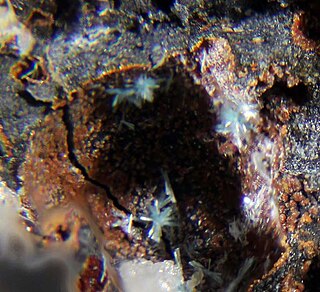
Mammothite is a mineral found in the Mammoth mine in Tiger, Arizona and also in Laurium, Attika, Greece. This mineral was named in 1985 by Donald R. Peacor, Pete J. Dunn, G. Schnorrer-Köhler, and Richard A. Bideaux, for the Mammoth vein (one of the two main veins in the mine) and the town of Mammoth, Arizona, which was named for the mine. The mammothite that is found in Arizona exist as euhedral crystals imbedded in micro granular, white colored anglesite with a saccharoidal texture. The associated minerals include phosgenite, wulfenite, leadhillite and caledonite. In Greece, the mammothite exists as small euhedral crystals and also as microscopic rock cavities lined with projecting crystals within the slags. The associated minerals here are cerussite, phosgenite and matlockite. The ideal chemical formula for mammothite is Pb6Cu4AlSb5+O2(OH)16Cl4(SO4)2.
Lahnsteinite is a basic sulfate mineral first discovered in the Friedrichssegen Mine, Germany in a goethite cavity. Though found in goethite, the crystals of Lahnsteinite are few millimeters in size, and are tabular shaped. Lahnsteinite was the first mineral discovered in the Lahn Valley deposits. The empirical formula for lahnsteinite is (Zn3.3,Fe0.27,Cu0.11)3.91(S0.98O4)(OH)5*3H2.10O.
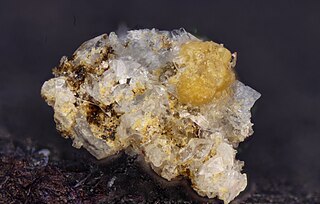
Zigrasite is a phosphate mineral with the chemical formula of MgZr(PO4)2(H2O)4. Zigrasite was discovered and is only known to occur in the Dunton Quarry at Oxford County, Maine. Zigrasite was specifically found in the giant 1972 gem tourmaline-bearing pocket at the Dunton Quarry. Zigrasite is named after James Zigras who originally discovered and brought the mineral to attention.
Lemanskiite is a mineral that was first discovered in a mine at Abundancia mine, El Guanaco mining district, Chile, with the ideal formula of NaCaCu5(AsO4)4Cl•3H2O. Originally, this mineral was discovered as being dimorphus with lavendulan, but in 2018 it was revised to only have 3 water molecules. Lemanskiite typically occurs as rosette-shaped aggregates of thin lamellar or needle-shaped aggregates, such as lammerite. Lemanskiite is dark sky blue with a light blue streak, it is brittle with an excellent cleavage plane. It was found on a dumping site in the abandoned Abundancia mine, El Guanaco mining district, Region II, Antofagasta Province, Chile The new mineral has been named after Chester S. Lemanski, Jr. This mineral and name were then approved by the Commission on New Minerals and Mineral Names of the International Mineralogical Association.
Cattiite is a phosphate mineral. The mineral was first found in a veins of dolomite carbonatites veins at the bottom of the Zhelezny (Iron) Mine in the Kovdor massif, Kola Peninsula, Russia. Cattiite was tentatively identified as Mg3(PO4)2•22H2O, which as a high hydrate magnesium orthophosphate. Later structural studies, revealed the existence of two polytypes named Mg3(PO4)2•22H2O-1A1 and Mg3(PO4)2•22H2O-1A2.
Hexahydroborite is a mineral composed of calcium, boron, oxygen, and hydrogen, with formula CaB2H12O6, more precisely [Ca2+]([B(OH4)]−)2·2H2O.
References
- ↑ Warr, L.N. (2021). "IMA–CNMNC approved mineral symbols". Mineralogical Magazine. 85 (3): 291–320. Bibcode:2021MinM...85..291W. doi: 10.1180/mgm.2021.43 . S2CID 235729616.
- 1 2 3 4 5 6 7 8 9 10 11 12 13 14 15 16 Erd, Richard C.; Czamanske, Gerald K. (1983). "Orickite and coyoteite, two new sulfide minerals from Coyote Peak, HunboldtCountry, California" (PDF). American Mineralogist. 68: 245–254.
- ↑ V. Pekov, A.A. Agakhanov (2007). Thallium-Rich Murunskite from the Lovozero Pluton, Kola Peninsula, and Partitioning of Alkali Metals and Thallium between Sulfide Minerals. Vol. 4. Zapiski Rossiskogo Mineralogicheskogo Obshchestva. pp. 74–78.
- 1 2 Evans, J.R.; Allmann, R. (1968). The crystal structure and crystal chemistry of Valleriite. Vol. 127. Zeitschrift flir Kristallographie, Bd. pp. 73–93.
- 1 2 3 Anthony, J. W., Bedeaux, R., Bladh, K. and Nicholas, M. (1990). Handbook of Mineralogy (PDF). Vol. 1. Mineral Data Publishing (Republished by the Mineralogical Society of America).
{{cite book}}: CS1 maint: multiple names: authors list (link)